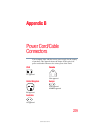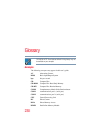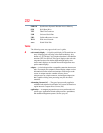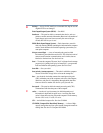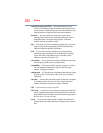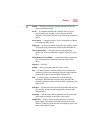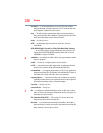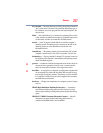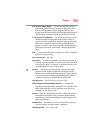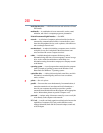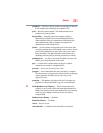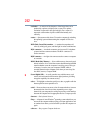
Glossary
237
file extension — The three characters following the period (pronounced
“dot”) at the end of a file name. The extension indicates the type of
file. Examples are .exe for program files and .hlp for help files. See
also file name.
folder — Also called directory. A container for organizing files saved to
a disk. A folder is symbolized on screen by a graphical image (icon)
of a file folder. A folder can contain files and other folders.
format — (verb) To prepare a blank disk for use with the computer’s
operating system. Formatting creates a structure on the disk so the
operating system can write information to the disk or read
information from it.
frontside bus — The primary pathway (bus) between the CPU and the
computer’s main memory. Also called “system bus.” See also bus.
function keys — The keys labeled F1 through F12, typically located on
the keyboard. Their function is determined by the operating system
and/or individual programs.
G
ground — A conductor to which all components of an electric circuit are
connected. It has a potential of zero (0) volts, is connected to the
earth, and is the point of reference for voltages in the circuit.
H
hard disk — A storage device composed of a rigid platter or platters that
can be magnetically coded with data. Hard disks are used for long-
term storage of programs and data. The primary (or only) hard disk
in a computer is usually fixed, but some computers have secondary
hard disks that are removable.
hardware — The physical components of a computer system. Compare
software.
HDMI (High-Definition Multimedia Interface) — An interface
used to transmit high quality audio and video signal via a single
cable in digital format, providing better picture quality than analog
signal.
HDMI-CEC (HDMI Consumer Electronics Control) — One A/V
component can control another while using this function, if
connected with HDMI cables. See also HDMI.



